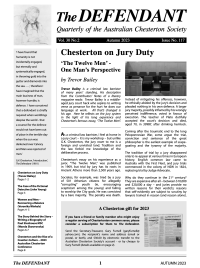John Young, a frequent contributor to The Defendant, reflects on the nature of the detective as conceived by various authors, including Chesterton, in their fictional works.
Edgar Allan Poe started something when he wrote The Murders In The Rue Morgue, the tale on which so many other detective stories have been based. It is the first locked room mystery; the private investigator solves the case, while the police arrest an innocent man; the reader is given the clues necessary to solve the mystery.

Berkeley, Agatha Christie, Chesterton (Club’s first President), Dorothy L. Sayers.
There have been variations on the theme, and all sorts of investigators, including the Holmes and Watson combination, in which the detective gives hints that leave his companion as mystified as ever.
For example, in The Redheaded League, when Holmes makes a point of seeing the shop assistant, Watson asks: “Why did you want to see him?”, and Holmes replies: “I didn’t want to see him. I wanted to see the knees of his trousers.”
This draws the reader into the story, giving him an opportunity to solve the riddle. And that is part of the fascination of the detective story: the reader can participate and (sometimes) solve the mystery. We are rational beings with a natural desire to exercise our intellect, and this provides an enjoyable way of doing so.
We also have a sense of justice, with satisfaction in seeing the good vindicated and evil overcome, which is the result in the detective story. And that, I suggest, partly explains the disproportionate number of what we may call religious detectives.
Chesterton’s Father Brown comes to mind immediately. There are also Ralph McInerny’s Father Dowling and Ellis Peters’ mediaeval monk Brother Cadfael. But a search on the internet reveals many others, including nuns.
In 1930 the Detection Club was formed, with G.K Chesterton as its first president. He remained president until his death in 1936. Agatha Christie, Dorothy L Sayers, Monsignor Ronald Knox, E.C. Bentley were all members of the club. It was a lighthearted association with a set of rules formulated by Ronald Knox, including the rule that the stories must not contain “mysterious Chinamen”. I was surprised to find on the Internet that the last entry for this club was recent: it is still in existence.
In her autobiography Agatha Christie regrets that she had made Hercule Poirot an elderly man on his first appearance. Logically he must have been extremely old by the end of his career! But a fictional detective can be ageless, as shown by Sexton Blake’s assistant Tinker, who remained an alert young man for half a century or so, despite having been rendered unconscious by blows on the head on various occasions.
Agelessness is shared by some series of school stories, notably the Greyfriars series by Frank Richards, which extended from 1908 to the 1960s. And in all that time the boys had the same teachers and remained in the same classes, with Billy Bunter for ever translating, or not translating, Virgil under the gimlet eye of Mr Quelch, his form master.
The amateur telling the professional
Father Brown makes the comment (I forget in which story) that the detective has the only profession in the world where the amateur tells the professional what to do. He points out that when you get a haircut you don’t tell the barber how to cut hair, and when you take a taxi you don’t explain the philosophy of taxi driving to the driver.
In the world of detective fiction, however, the Scotland Yard inspector is always very efficient except when an amateur is on the case, when the professional becomes muddled and is likely to arrest an innocent person.
The classic definition of man is “rational animal”. He is also a moral animal. These two attributes find expression in the detective story, with justice being done after a rational investigation of the clues, and the reader participating, if he is astute enough.
